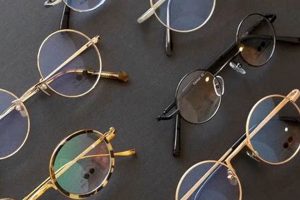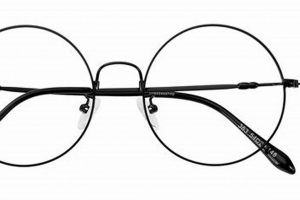Eye protection from earlier eras, specifically designed for industrial or occupational use, constitutes a unique category of collectible and functional items. These spectacles, goggles, or shields, manufactured in past decades, offer a glimpse into the safety standards and aesthetic sensibilities of their time. Examples include early 20th-century welding goggles with dark lenses and side shields, or acetate spectacles from the mid-century designed for factory workers.
These historical protective eyewear pieces are significant for several reasons. They showcase the evolution of safety technology and material science over time. Furthermore, they represent a tangible connection to the industrial history and labor practices of previous generations. The design elements often reflect the prevailing artistic and manufacturing trends, adding to their appeal for collectors and those interested in historical artifacts.
The subsequent discussion will delve into the specific materials, styles, and manufacturers associated with these historical eye protection devices, providing a detailed overview of their characteristics and significance. The aim is to offer a comprehensive understanding of their role in industrial settings and their current value as collectables.
Tips for Evaluating Historical Protective Eyewear
Assessing antique or period-specific safety eyewear requires careful attention to detail. The following guidelines provide a framework for evaluating the authenticity, condition, and historical significance of such items.
Tip 1: Research the Manufacturer: Identifying the manufacturer is crucial. Companies like American Optical, Bausch & Lomb, and Willson Products were prominent producers. Researching their historical catalogs and trademarks can aid in verifying authenticity and dating the item.
Tip 2: Examine the Markings and Stamps: Original markings, including the manufacturer’s logo, model numbers, and safety standards markings, are vital indicators. These markings should be clear and consistent with the period of manufacture. Absence of expected markings raises concerns about authenticity.
Tip 3: Assess Material Composition: The materials used in construction are indicative of the era. Early examples may feature celluloid, while later models utilized acetate, metal alloys, or early plastics. Inspect for degradation or inconsistencies in material composition.
Tip 4: Inspect Lens Quality and Type: Lens materials varied from glass to early forms of plastic. Inspect lenses for cracks, scratches, or discoloration. The type of lens (clear, tinted, or specialized for welding) provides clues about the intended use and period.
Tip 5: Evaluate Frame Construction and Style: The frame’s construction style, hinge mechanisms, and overall design reflect the manufacturing techniques of the period. Examine the integrity of joints, hinges, and nose bridges for signs of damage or repair.
Tip 6: Consider the Intended Use: Understanding the intended use (e.g., welding, grinding, chemical handling) helps contextualize the design and materials. Specialized features, such as side shields or ventilation, are indicative of specific applications.
Tip 7: Check for Modifications or Repairs: Authentic pieces should be largely original. Repairs or modifications can detract from the value and historical accuracy. Carefully examine for signs of alterations, such as mismatched screws or replaced components.
These guidelines ensure a more informed assessment. The correct assessment enhance understanding the history of safety standards and technology.
The subsequent sections will delve into specific examples and case studies to further illustrate these evaluation techniques.
1. Material Composition
The materials used in the construction of historical protective eyewear serve as significant indicators of their age, intended function, and the prevailing technological capabilities of the time. Material analysis provides crucial insights into the evolution of safety standards and manufacturing practices associated with these artifacts.
- Celluloid Usage
Early safety spectacles, particularly those from the late 19th and early 20th centuries, often incorporated celluloid, a flammable plastic, for frames. While lightweight and easily moldable, its inherent flammability posed a safety risk, highlighting the nascent stage of safety material development. The presence of celluloid strongly suggests an early manufacturing date and awareness of its limitations is essential for preservation.
- Metal Alloys in Frame Construction
Metal alloys, such as steel and nickel, were common in the frames of many examples, providing durability and resistance to impact. Specific alloys used, and their construction methods, can indicate the manufacturing period and intended use. The presence of corrosion-resistant alloys suggests exposure to corrosive environments, offering clues about occupational hazards.
- Glass Lens Variations
Glass lenses were the standard for optical protection. Variations in glass composition, such as the inclusion of lead for radiation shielding, reflect specific safety requirements. The presence of tempered or laminated glass denotes increased impact resistance and a later period of manufacture compared to standard annealed glass.
- Early Plastic Implementations
The introduction of acetate and other early plastics in the mid-20th century marked a shift toward lighter and more versatile materials. The specific type of plastic employed provides clues to the manufacturing date and the level of protection offered. Degradation patterns in plastics differ significantly, influencing preservation strategies.
The interplay between these varied materials and their application in vintage safety equipment underscores the dynamic relationship between technological advancement and the evolution of workplace safety. Recognizing these material characteristics is essential for accurate identification, preservation, and historical interpretation.
2. Manufacturing Era
The period in which a piece of historical protective eyewear was manufactured profoundly influences its design, materials, and intended purpose, thus forming a critical component in understanding the item’s significance. Advancements in material science, evolving safety regulations, and changes in industrial processes directly impacted the types of protection provided. For instance, pre-World War II safety spectacles often relied on celluloid frames and untreated glass lenses, reflecting the limited material options and comparatively lax safety standards of the time. Post-war models, in contrast, exhibit the use of more robust plastics and treated lenses designed to withstand higher impact forces, demonstrating a tangible response to increasing awareness of workplace hazards.
Understanding the manufacturing era provides practical benefits in several areas. Collectors can use period-specific features to verify authenticity and assess value. Researchers can analyze design trends to track the historical development of safety standards across different industries. Conservators require knowledge of manufacturing materials to implement appropriate preservation techniques, preventing degradation and ensuring long-term stability. The presence of certain materials or manufacturing techniques can further narrow down the production window, allowing for a more precise placement within the evolution of industrial safety.
In summary, the manufacturing era serves as a foundational element in characterizing safety spectacles from the past. By considering the available technologies, prevailing safety regulations, and evolving industrial needs, a comprehensive understanding of these artifacts and their place within the history of workplace safety can be achieved. The accurate identification of the manufacturing era ensures a more informed appreciation of the item’s purpose, design, and historical value.
3. Intended Application
The function for which historical safety eyewear was designed dictates its specific construction, materials, and protective features. Understanding this intended application is crucial for accurate identification, valuation, and historical interpretation of these items.
- Welding Protection
Eyewear intended for welding operations incorporates dark-tinted lenses to filter harmful ultraviolet and infrared radiation. The specific shade of the lens corresponds to the welding process and intensity. Side shields are commonly integrated to protect against peripheral light and sparks. Examples include early 20th-century goggles with adjustable lenses and leather side pieces, designed to shield welders from intense heat and radiation. The lens material is crucial, with specialized glass compounds offering varying degrees of protection.
- Grinding and Machining
Protective eyewear designed for grinding or machining operations primarily addresses the hazard of flying debris. These pieces typically feature clear lenses made from impact-resistant materials such as tempered glass or early plastics. Side shields may be present to provide additional protection against particles entering from the periphery. Examples are found in factory settings where workers used bench grinders or lathes, highlighting the need for robust eye protection against projectiles.
- Chemical Handling
Safety spectacles intended for chemical handling environments prioritize protection against splashes and fumes. These often feature close-fitting designs with sealed frames and lenses to prevent chemical exposure. Materials resistant to corrosion and chemical degradation are employed. Examples include goggles used in laboratories or manufacturing plants, designed to protect against corrosive substances. Ventilation features are often minimized or eliminated to prevent the entry of hazardous vapors.
- Dust and Particle Protection
Eyewear designed for dusty or particulate-laden environments, such as mining or woodworking, focuses on preventing the ingress of small particles. These types typically include close-fitting frames and sealed lenses to create a barrier against airborne irritants. Ventilation may be incorporated to reduce fogging, but with filters to prevent particle entry. Examples are seen in the mining industry, where workers were exposed to high concentrations of dust, emphasizing the necessity of sealed eyewear for respiratory and ocular health.
The intended application of historical safety eyewear dictates the specific design and materials used, shaping its value as both a functional artifact and a historical representation of occupational safety practices. By identifying the intended use, one can accurately assess the authenticity, condition, and relevance of these items within the broader context of industrial history.
4. Protective Features
Protective features are integral to the definition and function of vintage safety spectacles. The presence and nature of these features, such as lens tinting, side shields, and material composition, directly determine the eyewear’s effectiveness in mitigating specific workplace hazards. Without these attributes, the spectacles would not qualify as safety equipment. For example, dark-tinted lenses in vintage welding goggles served to protect workers from intense radiation; their absence would render the goggles ineffective and unsafe. Side shields provided peripheral protection against flying debris in grinding operations, illustrating a feature directly related to the task at hand.
The evolution of protective features in historical safety eyewear mirrors advancements in industrial safety standards and material science. Early models might incorporate simple features like celluloid frames and basic glass lenses, offering limited protection. Later examples showcase innovations such as impact-resistant lenses, improved side shield designs, and corrosion-resistant materials, reflecting a growing awareness of workplace hazards and the development of more effective protective measures. A comparative analysis of these features across different eras provides valuable insights into the historical trajectory of safety technology.
Understanding the protective features of historical safety eyewear is essential for collectors, historians, and safety professionals. Accurate identification of these features allows for proper categorization, valuation, and historical interpretation. Moreover, recognizing the limitations of older designs underscores the importance of modern safety standards and the continued pursuit of improved protective technologies. While these vintage items offer a glimpse into the past, they also serve as a reminder of the ongoing need for vigilance in workplace safety practices.
5. Maker's Marks
The presence of maker’s marks on safety glasses from past eras serves as a crucial element in establishing authenticity, provenance, and historical context. These marks, typically stamped, etched, or molded onto the frame or lenses, identify the manufacturer responsible for producing the eyewear. They offer direct traceability and allow for cross-referencing with historical records, catalogs, and company archives. For instance, the “AO” hallmark on vintage American Optical safety spectacles confirms the origin and production period, enabling researchers to verify design specifications and manufacturing practices of that era. The absence of such marks raises questions regarding the piece’s originality and necessitates further investigation.
Beyond authentication, maker’s marks provide insights into the competitive landscape of the safety equipment industry and the adherence to prevailing safety standards. Companies like Bausch & Lomb and Willson Products, prominent manufacturers of safety eyewear, often included unique identifiers that correlated with specific product lines and intended applications. These markings can be compared against known company catalogs and industry specifications to determine if the eyewear meets established safety requirements of its time. Furthermore, subtle variations in the maker’s mark itself, such as font changes or additions of patent numbers, can help pinpoint narrower production windows and trace the evolution of the manufacturer’s brand identity.
In summary, maker’s marks are indispensable components of vintage safety glasses. They provide crucial information related to authenticity, manufacturer identification, and historical context, allowing collectors, researchers, and historians to analyze these items within the broader framework of industrial history and safety technology. While the absence of a mark does not automatically invalidate a piece, its presence serves as a valuable starting point for detailed analysis and confirmation of origin, contributing significantly to a comprehensive understanding of safety eyewear from past eras.
6. Condition Assessment
The evaluation of the physical state of vintage safety spectacles is critical for determining their historical authenticity, functional integrity, and monetary value. The degree of preservation directly impacts the item’s usefulness as a collectible, research subject, or potential restoration project. A rigorous assessment includes examining the lenses for scratches, cracks, or discoloration; inspecting the frame for structural damage, corrosion, or material degradation; and evaluating the integrity of hinges, nose pieces, and side shields. The presence of original components, versus replacements, is also a key factor. Damage accrued through environmental exposure, such as prolonged sunlight or humidity, can accelerate deterioration, necessitating careful documentation and preservation strategies.
The condition of historical protective eyewear reveals information about its usage, storage, and past environments. For instance, spectacles used in heavy industrial settings may exhibit extensive wear and tear, providing insight into the harshness of the work environment and the level of protection afforded. Conversely, spectacles stored in controlled environments may retain their original clarity and structural integrity, offering a clearer representation of the original manufacturing quality. Assessing the lens material for clarity and any signs of chemical exposure or impact damage is vital, as compromised lenses may render the eyewear unsafe for display or potential use. Any repairs or alterations must be documented, as they may affect the historical accuracy and value of the item. The presence of original packaging or documentation can significantly enhance the assessment process, providing valuable context about the item’s history and intended use.
Accurate condition assessment is therefore essential for informed decision-making regarding preservation, restoration, and display of these historical artifacts. This detailed evaluation ensures that the significance of these items is not undermined by overlooked damage, thereby preserving the legacy of safety standards and industrial practices for future generations. The assessment guides appropriate storage, handling, and display protocols, minimizing further degradation and maximizing the longevity of these valuable historical resources.
Frequently Asked Questions
This section addresses common inquiries regarding historical safety eyewear, providing detailed and factual answers to enhance understanding and inform preservation efforts.
Question 1: What defines “vintage” in the context of safety glasses?
The term generally refers to safety spectacles manufactured at least several decades ago, typically before significant advancements in materials and safety standards. The precise cutoff year may vary depending on the specific context and collecting community.
Question 2: Are safety glasses from the past still suitable for modern workplace protection?
Generally, no. Historical examples are not designed to meet current safety standards and may lack the necessary impact resistance or protection against specific hazards. They are typically unsuitable for use in contemporary industrial settings.
Question 3: How can the authenticity of antique safety spectacles be verified?
Authentication involves examining manufacturer’s marks, comparing design features to historical catalogs, and analyzing material composition. Consultation with experts in antique eyewear or industrial history may be necessary for definitive confirmation.
Question 4: What are the primary materials used in constructing historical safety eyewear?
Common materials include celluloid, various metal alloys, glass (often with specialized treatments), and early forms of plastics such as acetate. The specific materials provide clues about the manufacturing period and intended application.
Question 5: What factors influence the value of old safety spectacles?
Value is determined by rarity, condition, manufacturer, historical significance, and completeness. Pieces associated with specific industries, notable individuals, or unique designs tend to command higher prices among collectors.
Question 6: How should vintage safety eyewear be properly stored to prevent degradation?
Proper storage involves maintaining a stable temperature and humidity level, protecting against direct sunlight, and utilizing acid-free archival materials for padding and containment. Regular inspection and gentle cleaning are also recommended.
These FAQs provide a foundation for understanding the significance and care of vintage safety spectacles. Further research and consultation with experts are recommended for in-depth analysis.
The next section will explore the legal and ethical considerations related to possessing and displaying these artifacts.
Conclusion
The examination of safety glasses vintage has revealed their multifaceted significance. Beyond mere artifacts, these items represent a tangible link to the evolution of industrial safety standards, material science, and manufacturing practices. Understanding their historical context, identifying their protective features, and assessing their condition are crucial steps in appreciating their true value. The study of maker’s marks and material composition provides insights into the specific manufacturers and eras of production, enhancing authentication and facilitating further research.
Continued preservation and scholarly investigation of safety glasses vintage are essential for maintaining awareness of past workplace hazards and informing future safety innovations. Further research into specific industries and manufacturers is needed to broaden our understanding. These artifacts serve as a poignant reminder of the ongoing need for vigilance and progress in protecting workers from potential harm, emphasizing the continuing significance of these historical objects.







